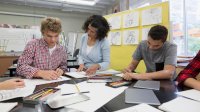How Creating Visual Art Contributes to SEL
A teacher-student research project looked at how social and emotional learning was enhanced when students spent time making art.
Your content has been saved!
Go to My Saved Content.“Art,” a high school student told me, “has the ability to affect people in ways nothing else can. For me, I’ve found art as a way to express what I’m feeling without even knowing it at the time. Art helps me understand my own life.”
Several years ago I was the chair for a Gifted Education department at a large public high school. Our crowded resource room was the space where my students and I spent most of our school day. In particular, the students from a counseling group I ran for high-achieving young women often spent several hours a day in the room. Occasionally, these students wouldn’t show up during their open study time—they were free to study anywhere they liked in the building. When they weren’t in our room, I usually found them in the art studio.
I was surprised that these self-identified “math and science kids” were there, but they told me that art helped them “figure things out,” even though they weren’t sure why. So we decided to try to find out, spending the rest of the school year engaged in a youth participatory action research (YPAR) project. In a YPAR project, students are co-researchers with adults. They make decisions about methodology, process, and how to share their findings.
As a research team, we met for weekly dialogues and read about art, aesthetics, and social and emotional learning. We used art as both data and method in our sense-making process. The project culminated in an art show and a conversation with district counselors and administrators.
This was not an art education project, nor am I an art teacher. Yet, with each passing week we came closer to understanding why art felt useful to the students.
My students and I identified four essential social and emotional learning (SEL) areas that drew us to crafting visual arts: storytelling, growth mindset, self-reflection, and creativity. And this project transformed my beliefs about the importance of visual arts in school. Now as a middle and high school principal, I work hard to insure that all students and teachers in my school have access to and are encouraged to create visual arts.
How Crafting Visual Arts Contributes to SEL
Storytelling: Creating art is a practice in both communication and empathy that affects the storyteller (in this case, the student artist) and the person viewing the story (peers, teachers, and counselors). Art gave the students I worked with new ways to process and tease out meaning, and to share their lived experiences.
One student shared a painting with me that she had created while thinking about her dating relationship. She was confused about this relationship and noticed in her painting that she tended toward dark and “angry” colors, as she put it. Art gave her a different emotional vocabulary to process this relationship, and it gave me new tools to talk with her about healthy relationships.
Growth mindset: The students working on this project were potential valedictorians, Presidential Scholar nominees, and National Merit finalists. They knew their way around a standardized test and were mavens at finding the right answer.
These students’ perfectionism had been reinforced by the high-stakes nature of high school, and so they were drawn to the ways art invited them to take risks, test solutions that might not work, and play with possibility. This is a growth mindset arena, and students were so engaged that they lost track of time. This is why I would sometimes find these young women painting in the art studio, oblivious to how much time had passed.
Self-reflection: Through art, students often discovered inner monologues that had been drowned out by the busy and hyperacademic context of school. The art studio invited them to slow down, settle in with a canvas, and figure things out.
In our dialogues, we talked at length about process, story, and identity. Because this was a research project, the students wanted to “graph” their findings—but the fact that we were using the visual arts as data points led to some innovative graphs. For example, one week we drew a vertical axis from anticipation to trepediation and a horizontal axis from judgment to value.
A student named Shaina placed an intense new painting in the judgement/trepidation quadrant. The painting showed giant purple hands gripping, almost suffocating, miniature green hands that were attempting to break free. “The concept for this piece,” she explained, “is all the different forces that control us.”
While working on this painting, Shaina had realized how her feelings of value and judgment were exacerbated by the college application process. She used her painting as a reflective springboard to discuss these pressures with her parents and peers.
Creativity: “I was never really an ‘art kid,’” one of the students said. “In fact, I only seriously started spending time on art this year. What shocks me is how differently I think now. Struggling with these art projects taught me more about creativity and communication than any other class I’ve taken.”
Creating art asks that you consider multiple perspectives and imagine new possibilities. These abstract and divergent thinking skills are transferable across content areas. In fact, students shared that the lessons they learned in art helped them also see new solutions in science, math, and language arts.
Through this project, my students were able to pull half-formed sketches out of the quiet margins of their math books and bring them to light on big, bright canvases. Here they had space to develop their ideas into complete and interesting stories that caused their peers, educators, and administrators to pause, ask new questions about the lived experiences of the young people in our building, and pay attention.
